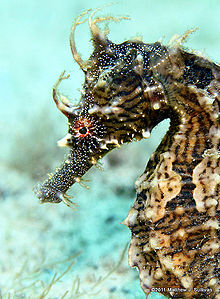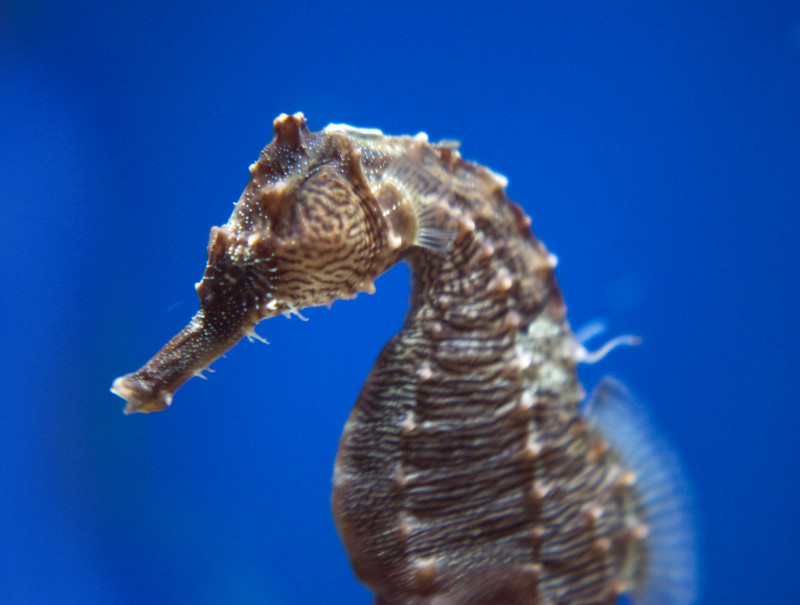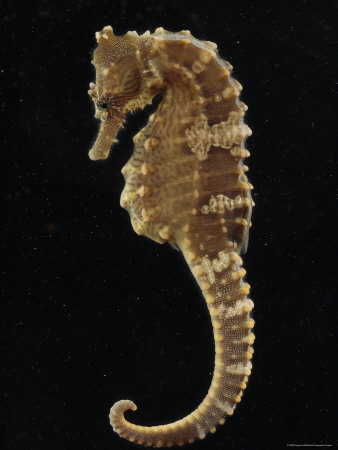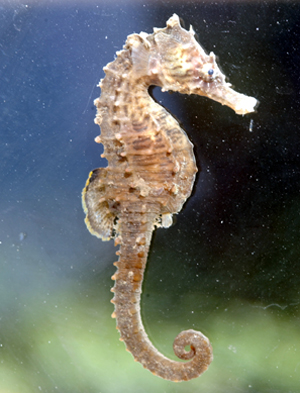
Hippocampus erectus
FAMILY
Syngnathidae
TAXONOMY
Hippocampus erectus Perry, 1810, West Indies.
OTHER COMMON NAMES
English: Seahorse.
PHYSICAL CHARACTERISTICS
Body erect and somewhat sinuous, with head at a right angle in
relation to the trunk and tail. Snout moderately long, with
small upturned mouth devoid of teeth. Eyes round. Two pairs
of spines present behind the eyes on the head. Small pectoral
fins with 14–17 rays; single posterior dorsal fin with 16–20
rays; small anal fin with three to four rays; no pelvic fins. Prehensile
tail tapers into a slender stalk without a caudal fin.
Trunk encased in 10–12 bony rings, each with four spines; tail
has 32–38 rings. Coloration varies widely—background light
brown, black, gray, or yellow (sometimes red) with various
small blotches, stripes, and spots. Area around the eyes has
small white stripes radiating from the eyes. Reaches 7.9 in (20
cm) in length.
DISTRIBUTION
Western Atlantic from Cape Cod (sometimes Nova Scotia as
strays) to Uruguay. The extensive range suggests that the name
H. erectus may be applied to a complex of closely related
species.
HABITAT
Lined seahorses are found in habitats with heavy vegetation,
such as seaweeds and sargassum, in shallow waters and waters
as deep as 240 ft (73 m). Present also in bays, piers, beaches,
salt marshes, oyster beds, and other environments in which
vegetation and shelter are present. They are capable of tolerating
great variations in temperature and salinity.
BEHAVIOR
Seahorses swim slowly, in a vertical position, by undulating
the dorsal and pectoral fins and tend to cling with their prehensile
tails to vegetation, gorgonian corals, and so forth.
They produce sounds to communicate with each other.
Younger individuals tend to be pelagic, sometimes swimming
in groups.
FEEDING ECOLOGY AND DIET
Food consists mostly of small crustaceans, such as copepods,
amphipods, and larvae. They employ pipette feeding, after a
swift sucking action following a sudden upswing of the head.
They are eaten by many species of bony fishes, including cod,
bluefish, remoras, and spiny and smooth dogfishes.
REPRODUCTIVE BIOLOGY
Between 250 and 400 eggs are deposited in the male’s brood
pouch during courtship (the larger the female, the greater the
number of eggs). Males develop brood pouches by about 3 in
(7.5 cm) in length, and males with eggs are recorded at 3.5 in
(9 cm). In courtship the male and female closely follow each
other, and the male presents his pouch to the female’s genital
area. As eggs are being transferred from the female into the
male’s pouch, they both rise in the water and may change
color. Breeding takes place in the summer or year-round in
tropical climates. Females deposit a few eggs at a time repeatedly.
The eggs develop in the brood pouch and may derive
nourishment from secretions within the pouch. Eggs are pearshaped
and light orange in color and may contain one or more
oil droplets. Eggs are incubated for 12–14 days in the pouch;
there is no true larval period; miniature seahorses are expelled,
measuring about 0.24 in (6 mm) in length. Their tails become
prehensile after one day, and they become mature after three
months.
CONSERVATION STATUS
Listed as Vulnerable by the IUCN.
SIGNIFICANCE TO HUMANS
A common aquarium species whose commercialization requires
monitoring.
Photo Gallery of - Lined seahorse





 Animalia Life
Animalia Life